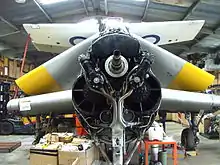| Double Mamba | |
|---|---|
 | |
| Preserved Double Mamba at the Imperial War Museum Duxford | |
| Type | Turboprop |
| Manufacturer | Armstrong Siddeley |
| First run | 29 September 1949 (First flight) |
| Major applications | Fairey Gannet |
| Developed from | Armstrong Siddeley Mamba |
The Armstrong Siddeley Double Mamba is a turboprop engine design developed in the late 1940s of around 3,000–4,000 hp (2,200–3,000 kW). It was used mostly on the Fairey Gannet anti-submarine aircraft developed for the Fleet Air Arm of the Royal Navy.
Design and development
The Double Mamba (rarely known as the Twin Mamba) was a development of the Armstrong Siddeley Mamba with two Mambas driving contra-rotating propellers through a combining gearbox.[1]
Engine starting was by cartridge, however, forced air restart was achieved in flight. One engine could be shut down in flight to conserve fuel. Shutting down one engine also stopped one of the propellers.
Variants

- ASMD.1
- 2,950 shp (2,200 kW) (2 x ASMa.3) used on Fairey Gannet A.S. Mk.1 and Blackburn B-88
- ASMD.3
- 3,145 shp (2,345 kW) (2 x ASMa.5) used on Fairey Gannet A.S. Mk.4
- ASMD.4
- 3,875 hp (2,890 kW) (2 x ASMa.6) used on Fairey Gannet AEW Mk.3
- ASMD.8
- 3,875 hp (2,890 kW) (2 x ASMa.6) used on Fairey Gannet AEW Mk.3
Applications
The Double Mamba engine was also proposed for the Westland Westminster, a 30-seat helicopter that was later built as a prototype powered by a pair of Napier Eland E220 turboshaft engines.
Engines on display
Preserved Double Mamba engines are on public display at the:
Specifications (ASMD.3)



Data from Flight[2]
General characteristics
- Type: Turboprop engine
- Length: 102.25 in (2,597 mm)
- Diameter: 52.8 in (1,341 mm)
- Dry weight: 2,170 lb (984 kg)
Components
- Compressor: 10 stage axial (x2)
- Combustors: Six combustion chambers (x2)
Performance
- Maximum power output: 2,960 eshp (2,207 kW)
- Overall pressure ratio: 5.35:1
- Air mass flow: 18.5 lb/sec (8.4 kg/s) per single Mamba unit
- Specific fuel consumption: 1.71 lb/(lbf·h)
- Power-to-weight ratio: 1.36 eshp/lb
See also
Related development
Comparable engines
Related lists
References
Notes
- ↑ Gunston 1989, p.20.
- ↑ Aero Engines 1954 Flight International magazine, Flight Global/Archives, 9 April 1954, on www.flightglobal.com. Retrieved: 29 October 2016
Bibliography
- Gunston, Bill. World Encyclopedia of Aero Engines. Cambridge, England. Patrick Stephens Limited, 1989. ISBN 1-85260-163-9